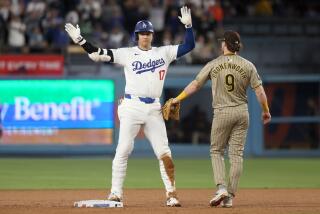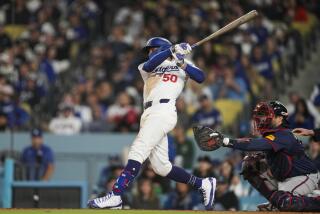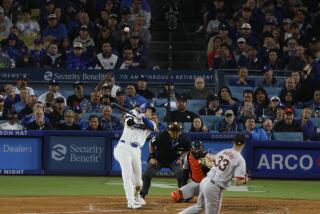DON MATTINGLY : RAISES HIS HORIZONS
An hour before game time on July 8, Don Mattingly had no idea what was ahead of him. Certainly he had no notion he was about to hit home runs in each of his next eight games--a total of 10 homers in all.
However, like the student of baseball he’s always been, Mattingly was talking about how a fine hitter becomes a fine slugger as the years progress.
“Location is the most important (aspect) of (both) hitting and pitching,” he said. “If the pitchers could throw it where they wanted every time, even if their stuff wasn’t that great, you’d be just about helpless.
“What you learn is that none of them can. If you’re patient, you can do a lot of things. Everybody can’t get you every time.”
And, as the seasons pass, you begin to realize that, when you get ‘em, it can be for four bases, not just one.
That afternoon, 6-foot-7 Mike Smithson got a first-inning fastball where Mattingly was expecting it and the ball landed 15 rows in the right-field bleachers. In the sixth, Juan Berenguer tried to get inside on Mattingly, but the Yankee clubber was a step ahead. The homer missed the upper deck on its way down from the clouds, but not by much. A great hitter was suddenly red hot.
When Mattingly stepped to the plate Sunday night in Texas, trying to become the first man ever to hit a homer in nine consecutive games, he was underlining a much larger point than simply his own excellence. He was illustrating an issue which recurs in every generation.
Most great young batsmen arrive in two classic categories: hitters and sluggers. As they mature, each group faces the hard task of trying to become more like the other. Those who start off hitting singles and doubles must decide if they can or should graduate to home runs. And those who begin with a feast or famine swing must decide whether the quest for .300 is realistic or just a tormenting Chimera.
Occasionally, a Ted Williams, Willie Mays or Frank Robinson comes on the scene with the magic mix already in place. Far more often players like Reggie Jackson and Mike Schmidt, Jose Canseco, Darryl Strawberry and Pete Incaviglia, must find out if they can shrink the “holes” in their strike zone, and at what cost. Conversely, the men who announce themselves by winning silver bats--such as Mattingly, Wade Boggs and Tony Gwynn--must find out if they will improve themselves, or destroy themselves--by trying to hit 30 or 40 home runs.
Seldom do sluggers learn to hit .300, much less .330. On the other hand, pure hitters quite often become masters of the homer. We’ve seen that growth process from Stan Musial and Hank Aaron to Carl Yastrzemski and George Brett.
Stan the Man never had his first 20-home-run year until his sixth season; yet, he ended with 475 homers. Yaz was even more dramatic. After averaging 16 homers for his first six years, he hit 44, 23, 40, 40 and ended up with 452.
Aaron was the perfect example. He hit 13 as a rookie, then leveled off at 27 and 26 homers, just like his smooth, slim contemporary, Al Kaline, who’d won a batting title in 1955 (one year before Aaron). The two stylish, understated right fielders could not have seemed more similar. Yet Aaron was the better analyst and learned how and when to go for the fences. Kaline, despite playing in a home run heaven, never had a 30-homer year. His 399 home runs were wonderful, but Aaron found a way to hit 755.
Each decade isolates this process anew. Raw strength is seldom the key issue. Almost anybody gifted enough to hit .350 can lift enough weights to drive a ball 380 feet, which is all it takes. Some, like Rod Carew, never even take the first steps of the transition, prefering the aesthetic mantle of the artist. Others, such as Roberto Clemente, Al Oliver, Keith Hernandez and Bill Buckner end up in the middle.
The same truth hides behind all their careers, however; to reach the very top as a hitter, you need the home run in your game. Look at 17-year veteran Cecil Cooper. In the seasons when he did not hit more than 20 homers, he never drove in 100 runs and only reached 80 once; for a first baseman, that’s barely earning your keep. The season he finally hit 24 homers, he had 106 runs-batted in. When he hit 25, 30 and 32 homers, he averaged 123 RBI and was truly great.
Proof that size can be immaterial is the case of Dave Parker. He won back-to-back batting titles, but earned a reputation as a frustrated giant whose most vicious blasts were top-spin liners that dented walls but seldom flew over them; he didn’t average 20 homers a year for his first dozen seasons. The last two years, he’s gotten some uppercut in his stroke: 65 homers and 241 RBI.
So far, Mattingly, now 26, is far ahead of the two men in his generation who may be equally gifted pure hitters--Boggs and Gwynn. In the minors, Mattingly never hit more than 10 homers. As a rookie, only four in 279 at bats. Then, he started lifting weights and bulking up with age.
The home runs arrived as he figured out how to look for prime pitches in advantageous spots. Nothing wrong with an awkward swing and miss occasionally. After 23 homers in ‘84, he amazed even himself with 35 (and 145 RBI) in ’85. Last year, his 31 homer and 113 RBI totals, along with a .352 average, seemed like the sort of ideal compromise which he may be able to maintain through an historic career.
Gwynn has dedicated himself to learning to pull, but just doesn’t have the knack yet. His five homers this season are not too bad for a player who, just three years ago, counted all his batting practice homers for the entire season and never got to 30. Boggs falls into the middle range and shows promise. Helped perhaps by the mystery ball of ‘87, he has 17 homers and 56 RBI a pace that may get him to 30 homers and 100 RBI this year.
Still, that’s not the 145 RBI year that Mattingly already has produced. Even with a three-week injury in ‘87, he is on a 120 RBI track.
What’s most amazing about him is his ability to improve continually through diligence. Though only 5-11, he has built his upper body to the point where he looks like he could tear the limbs off the Mattingly of 1984.
At the moment, his streak raises stunning questions. No, not the question of how many consecutive games a man can homer in. Our queries are even more fun than that.
If Don Mattingly ever hits 40 to 45 homers a year, instead of 30 to 35, how good would he be then? And, if he gets there, would any first baseman, even Lou Gehrig, ever have been better?
More to Read
Go beyond the scoreboard
Get the latest on L.A.'s teams in the daily Sports Report newsletter.
You may occasionally receive promotional content from the Los Angeles Times.










